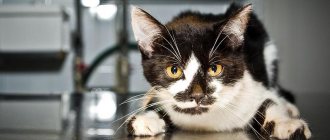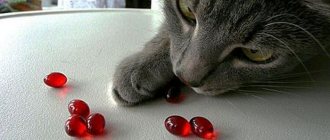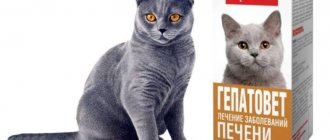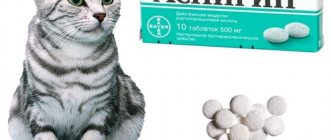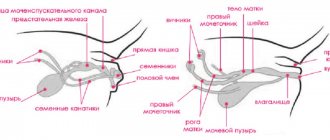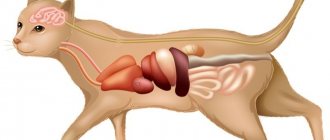What will you learn from the article?
- Causes
- Diagnostics
- Classification of liver diseases
- Major liver diseases in cats Hepatitis in cats
- Lipidosis (fatty hepatosis)
- Cirrhosis of the liver in cats
- Gallstone disease in cats
- Cholecystitis in cats
- Severe liver failure (hepatargia)
- Cholangitis
- Liver amyloidosis
- Liver cancer
The liver is a vital organ, which is called the “factory of the body.” The condition of the animal as a whole depends on its health. Liver diseases in cats account for up to 30% of all non-communicable diseases. Improper feeding, saving on the purchase of quality food, lack of vitamins, minerals and amino acids, poisoning and helminthic infestations - all this causes a blow to the liver. If we exclude all of the above, then the cat’s liver, in most cases, will work perfectly, neutralizing toxins, allergens, and poisonous substances that enter the cat’s body.
In this material we will look at why cats have liver pain and their causes, we will tell you what signs should alert the owner, we will talk about diagnostic methods, methods of treatment and prevention.
Main signs of liver diseases and their types
Liver diseases in cats very often remain invisible to their owners, since signs of the disease can be confused with food allergies and bad mood. In this case, it is important to be very attentive to your pet.
Most often, cats suffer from the following liver diseases:
- Cirrhosis of the liver;
- Cholecystitis;
- Cholelithiasis;
- Hepatitis;
- Lipidosis;
- Cholangitis;
- Liver failure.
In some cases, malignant and benign tumors, amyloidosis, peliosis and other liver diseases are diagnosed.
All liver diseases can be divided into 2 types: primary and secondary.
- In primary diseases, the lesion is localized within the liver.
- Secondary liver diseases are caused by problems in the body that have nothing to do with this organ.
As a rule, liver diseases in cats have certain signs. The owner’s task is to detect the disease in a timely manner and provide quality treatment. Such actions will prevent the development of extreme stages of the disease that threaten the pet’s life.
Common signs of liver disease in cats:
- stomach disorders: vomiting and diarrhea;
- lack of appetite;
- weight loss;
- apathetic state;
- yellowing of the mucous membranes;
- change in color of stool and urine;
- severe itching;
- enlarged abdomen as a result of fluid accumulation in it;
- problems with blood clotting;
- protrusion of the liver;
- hemorrhages in the skin;
- When pressing on the area in the liver area, the cat shows severe anxiety.
The presence of one or more of the above symptoms is grounds for urgent contact with a veterinarian.
Symptoms of liver disease in cats
In most cases, pathologies occur without any signs, so liver disease in cats, symptoms and treatment of the disease can only be determined by an experienced veterinarian.
Diseases of the organ have similar symptoms to ordinary illness or poisoning, and the owner of the animal is not always able to recognize liver disease in cats in time and seek help from a specialist.
The owner must take his pet to the veterinarian if symptoms such as:
- loss of interest in food;
- lethargy, apathy;
- weight loss;
- yellowness of the mucous membranes;
- vomiting, diarrhea;
- enlargement of the abdominal cavity (ascites);
- dark urine and light feces;
- skin itching;
- strong thirst;
- poor blood clotting;
- pain in the liver area.
The most common sign of liver disease is jaundice. Yellowing of the mucous membranes, and sometimes the skin, signals that the disease has become serious.
Very often the liver is greatly enlarged in size, and from the outside it seems that the right side of the animal seems to be sticking out.
Diagnosis of liver diseases in cats is carried out using laboratory and instrumental methods:
- General analysis of urine and blood. If there are problems with liver function, the level of bilirubin in the blood will be elevated.
- Specific blood test. Allows you to determine the level of bile acids produced by a parenchymal organ.
- Ultrasound examination. Able to assess the size of the liver and see whether there are structural changes in the tissues of the organ. Ultrasound can detect the disease at an early stage.
- X-ray. Just like ultrasound, it helps to assess the external and internal condition of the liver.
- Biopsy. It is the most accurate procedure for diagnosing organ diseases. A piece of liver tissue is removed using a long needle inserted into the abdominal cavity. This manipulation is performed under general anesthesia and only for those cats that do not have problems with blood clotting.
After carrying out all diagnostic measures and receiving the results, the doctor prescribes the necessary treatment for the sick patient.
What is hepatopathy
Allergens, toxins, gases and any other harmful substances that enter the body are neutralized in the liver cells. If poisons are not completely neutralized, there is a possibility of developing an abscess. All inflammatory diseases (cholecystitis, cholelithiasis, hepatosis, cirrhosis, etc.) are combined into the concept of hepatopathy. Many symptoms of liver disease are similar to allergies and the presence of parasites in the body, but there are also quite specific signs.
The liver is 100% severely damaged if:
- Urine is bright orange (owners should also be wary of the brown color);
- The cat is always thirsty;
- The mucous membranes and skin are characterized by increasing jaundice;
- Impaired bowel movements, frequent diarrhea and vomiting.
- skin itching.
Signs of liver disease
Liver pathologies do not cause specific symptoms. But indirect signs indicate liver dysfunction:
- Vomit;
- Skin itching;
- Jaundice, in which the mucous membranes and skin turn yellow;
- Darkening of urine to brown color;
- Modification of feces to gray color;
- Hepatic coma;
- Bloating as fluid collects in the peritoneum;
- An increase in the size of the liver so much that it extends beyond the abdominal wall;
- Anemia;
- Hepatic colic – pain syndrome;
- Blood clotting disorder.
For each of the above diseases there is a certain sign that is noticeable during an external examination of the animal. This pathology can be parenchymal, mechanical, or hemolytic in nature.
The liver performs a huge function in the life of any organism, including cats. Like any other organ, the liver is susceptible to various types of diseases.
.
Obstructive jaundice is a consequence of blockage of the bile ducts. With this problem, bile does not penetrate the intestines, as a result of which the digestive process is upset.
Parenchymal jaundice is formed when liver cells are damaged. The developed inflammatory process prevents liver cells from being able to cope with the utilization of harmful substances formed in the intestines, and they collect in the bloodstream. With this pathology, symptoms of cholemia and unbearable itching appear.
Hemolytic jaundice occurs due to the breakdown of red blood cells due to invasion or infection.
Cirrhosis of the liver
Changes in the structure of the liver and overgrowth of connective tissue in it are called liver cirrhosis. This condition is characterized by loss of appetite, shortness of breath, and deterioration of heart function. The main sign of cirrhosis of the liver is an increase in its size and accumulation of fluid in the abdominal cavity of a cat. This liver disease can also be recognized by the appearance of jaundice and diarrhea, and redness of the conjunctiva.
Causes of liver cirrhosis:
- long-term intoxication of the body;
- hepatitis;
- infectious diseases caused by bacteria and viruses;
- insufficient amount of proteins and vitamins in the animal’s body.
Before starting treatment for liver cirrhosis, it is important to find out the cause of the disease. Based on these data, subsequent treatment methods are prescribed. As a rule, vitamins, diuretics, intravenous administration of salts, glucose and proteins are used to treat liver cirrhosis in cats.
To prevent this disease, it is recommended to undergo periodic veterinary examinations and feed your pet only high-quality food. The cat's heredity significantly influences the possibility of developing liver cirrhosis.
Most common liver diseases
The most common liver pathologies in cats include hepatitis, cirrhosis, lymphocytic, neutrophilic cholangitis, which are included in the general group of cholangitis syndrome in cats, cancer and other ailments.
Neutrophilic cholangitis
The pathology is characterized by damage to the bile ducts as a result of infection with pathogenic bacterial flora. Experts suggest that the source of infection is the intestines, but the etiology of the disease is not completely clear.
The disease usually manifests itself acutely - the animal vomits repeatedly, the mucous membranes and skin turn yellow, there is general malaise and signs of intoxication - decreased activity and appetite, a lethargic state.
Young individuals are susceptible to the disease. Treatment leads to complete recovery within one to one and a half weeks. Relapses are observed in rare cases; chronicity of the disease is not typical.
Lymphocytic cholangitis
Unlike neutrophilic, it is not associated with an infectious process. Experts suggest that a disorder of the immune response plays a major role in the pathogenesis of the disease. Most often, middle-aged and elderly animals are susceptible to pathology.
The resulting autoimmune complexes affect the bile ducts, resulting in a gradual increase in liver size, disruption of its function, and accumulation of ascitic fluid in the abdominal cavity. In the terminal stage, the pathological process also involves the liver parenchyma. There are high risks of transition of neutrophilic cholangitis to cirrhosis.
As a rule, animals respond well to treatment, but the course of therapy lasts several weeks. Recovery is often replaced by relapses of the disease and the acute course of neutrophilic cholangitis becomes chronic.
Hepatic lipidosis
Hepatic lipidosis is a disease caused by the deposition of lipids in hepatocytes. Fatty liver is manifested by dyspeptic disorders - nausea, vomiting, stool disorders develop, and the animal refuses to eat for a long time. Jaundice may appear.
Severe liver failure develops in the absence of adequate therapy. In this case, the cat exhibits signs of depression of the central nervous system - behavior changes, lethargy and increased salivation are noted, and an unusual tilt of the head may appear.
The causes of the disease are unknown. In many cases, the development of the disease is preceded by the pet's hunger or stress, intestinal diseases, or inflammation of the pancreas.
Poisoning
Food poisoning, as well as toxic substances, can occur, for example, while walking, when an animal eats food from the ground or from a trash can. Intoxication with salts of heavy metals, industrial compounds and other toxic substances often leads to the formation of hepatitis, cirrhosis and death of the pet.
Hepatitis
Hepatitis is an inflammation of the liver tissue, in which there is no violation of its architectonics. The etiological factor is infectious agents, as well as poisoning by toxic compounds.
Pathogenesis consists of infiltration of the liver with viral metabolites, bacterial waste products or toxins, resulting in local inflammation of the tissue. Massive poisoning can lead to the development of cirrhosis.
Symptoms are usually represented by yellowing of the mucous membranes and skin, nausea, vomiting, abnormal stool, and general poor health of the animal.
Yellow mucous membrane in a cat
Hepatosis
Develops due to the accumulation of lipids in the liver. Hepatosis can occur against the background of existing pancreatitis, cholecystitis and other ailments. Most often, the fatty form occurs, less often - the pigmented form, in which the metabolism of bilirubin is disrupted.
The pet experiences dyspeptic disorders, loss of appetite and weight, and a depressed state.
Cirrhosis
Cirrhosis is a chronic liver disease in which a structural disorder of the organ’s architecture occurs and the formation of regenerated nodes against the background of fibrosis, that is, replacement of the parenchyma with connective tissue. The disease is characterized by a severe course that cannot be treated. As a rule, it develops against the background of hepatitis, which can occur due to a lack of vitamins, poor nutrition, toxin poisoning, the presence of stones in the bile ducts, and helminth infestation.
Symptoms of cirrhosis in cats include signs of intoxication, loss of appetite, ascites, and jaundice. In the terminal stage, liver failure occurs as a result of toxic damage to the brain - the animal can become aggressive, restless, and gait is impaired.
Liver cancer
Cats are susceptible to cancer. Liver cancer often develops. The origin of atypical tumor cells can originate from both the hepatocytes themselves and the bile ducts and other structures of the liver. Most often, malignant liver tumors are metastases, and their introduction is possible both hematogenously and lymphogenously. The disease is characterized by a severe course, ending in death.
Helminthiasis
Helminthiasis is a group of infectious diseases caused by parasitic worms. There are a large number of helminths that can infect the internal organs of cats. The most favorite habitat is the liver. Invasion of an organ by parasites leads to the gradual destruction of its structure. Without taking medications, liver cirrhosis develops. Read the article about deworming cats and kittens.
Infectious diseases
Cats are susceptible to infection by Leptospira bacteria. As a result of infection, leptospirosis develops. The disease affects the liver and other internal organs. Infection occurs through contact with other animals and their biological secretions.
The clinical picture is represented by hepatomegaly, ascites, but, as a rule, there is no jaundice.
Medications
For the treatment of liver diseases, a line of drugs is produced that are used by veterinarians in their practice.
Hepatovet
Hepatovet for cats is produced in the form of a suspension. It includes:
- immortelle – has an antibacterial effect, promotes the removal of bile;
- lecithin – helps restore liver cells, normalizes its function;
- ornithine – optimizes acid-base balance and insulin levels;
- methionine – promotes creatine synthesis and has powerful antioxidant properties;
- Milk thistle – exhibits an antiseptic, anti-inflammatory effect.
The dosage of the drug is prescribed based on the cat’s weight, on average 1 ml per 3 kg of pet’s weight. The suspension is mixed with food and fed to the animal. Duration of treatment is 4-6 weeks. If necessary, the drug is repeated after a month.
The suspension is considered low-toxic and there are practically no contraindications. The exception is animals with epilepsy, severe liver failure, or encephalopathy.
Hepatoject – hepatoprotector
The drug is used in mono or complex therapy of liver diseases. Helps normalize its functions, restore cells after toxicosis, infectious and somatic diseases. Reduces the toxic effects of medications used on the organ.
The drug is administered intramuscularly or intravenously in a dose of 2 to 5 ml. The course of treatment is 7 days, twice a day. Contraindications – individual intolerance.
Hepatolux
Hepatolux is a drug used in the treatment and prevention of liver diseases. It is used for hepatitis, liver degeneration, diseases of the gallbladder, and animal ducts.
- Promotes the restoration of organ cells and the resumption of normal fermentation.
- Improves the cat's metabolism and appetite.
- It is effective for various intoxications and general dehydration of the body.
- Reduces the effects of medications.
- Prevents the increase in the size of stones, the occurrence of liver cirrhosis, and cancer in the pet.
- Significantly improves the general condition of castrated, sedentary, aging animals.
The drug is administered into the cat's mouth using a special syringe. Dose – 0.1 ml per 1 kg of body weight, twice a day. Used for 1 month. In chronic stages, treatment is carried out several times a year.
If you follow all the veterinarian's recommendations, after a while your pet will feel much better.
Cholecystitis
Inflammation of the gallbladder (cholecystitis) occurs as a result of the formation of stones in it or the presence of giardiasis. Most often, this disease develops after a cat eats stale food contaminated with eggs and larvae of parasites, or poor quality food.
Symptoms of cholecystitis:
- elevated temperature;
- diarrhea;
- constipation;
- pain in the liver area.
To treat cholecystitis, special drugs are prescribed against microbes and parasites, as well as choleretic agents. The diet is reviewed and harmful foods are removed from the cat’s diet. The main preventive methods against the development of this disease are the use of anthelmintic drugs, timely vaccination, feeding the animal with high-quality feed and mandatory heat treatment of fish, which most often contain parasite eggs.
Why does it appear?
In general, acute liver failure in cats can occur due to any pathology that somehow affects this organ. For old cats, stones are a real hit. They appear especially often in those animals that have been eating exclusively dry food throughout their entire “conscious life.”
An alternative is frequent feeding of fish, which, contrary to popular belief, is not at all suitable food for cats. Such a diet sooner or later leads to a whole bunch of problems. In neutered cats, stones, as well as liver failure, are often detected. Of course, in the overwhelming majority of cases, tumors appear in the kidneys, but the liver is not immune from them.
The second common cause of failure in cats is liver parasites. That's right: alveococcus, echinococcus, opisthorchus (cat fluke) and others. Firstly, these animals eat mice, which carry (are secondary hosts) the same echinococci. Secondly, many owners persistently “stuff” the same raw fish into their pets, which also often contains many parasitic “gifts”. If you do not know how to feed your cat, it is better to consult with experienced breeders!
Again, due to their “predilection” for mice, cats are very predisposed to poisoning. Nowadays, the fight against rodents lies mainly on the shoulders of deratization services, which use a variety of poisons in their work. The result is toxic liver degeneration in cats. What other reasons are there? The thyroid gland may also be involved in the occurrence of liver failure.
Hyperthyroidism is not uncommon in cats, and therefore liver failure syndrome is also very common in cats. Please note that the body of many animals can compensate for disturbances for a long time due to its high regenerative ability. But then “something” happens that is very stressful.
Details
Causes of liver problems in cats
Liver diseases in cats are similar in their external manifestations, but the causes of their occurrence are often different. In order not to endanger the health of your meowing pet, it is important to know the main causes of liver disease in cats:
- An inflammatory process that can penetrate from a neighboring organ through the bloodstream into the liver tissue, continue there and ultimately lead to the replacement of the organ tissue with connective tissue.
- Severe poisoning from any toxin. It doesn’t matter whether the cat inhaled household chemicals or ate some kind of poison or spoiled product. Any poisoning provokes destructive processes in the liver.
- Stones in the liver and ducts. Most often, stones form in the kidneys, but the liver sometimes gets its share of hard pebbles and sand. Most often, this process is caused by a diet with a high calcium content, incorrect or low-quality food. Also at risk are neutered cats and breeds with a genetic tendency to form stones.
- Kidney parasites - alveococcus, echinococcus, opisthorch. A cat can pick up all this fauna either from raw fish or by eating an infected mouse on the street.
- Poor nutrition, injuries in the liver area - all this most often leads to cirrhosis, but can become a provoking factor for the rest of the list of liver diseases in cats.
Symptoms of liver problems in cats
Regardless of what kind of disease has affected the liver, the symptoms of any liver failure in a cat will be similar. Such clinical manifestations include:
- Vomit. Appears due to general poisoning by toxins that the organ does not filter or remove.
- Loss of appetite. Again, this is due to the presence of unresolved toxins.
- Weight loss. Consequence of the first two symptoms.
- Intense thirst. The cat intuitively tries to cleanse its body of accumulated toxins, drinks water and partially shifts the filtering function to the kidneys.
- The stool becomes lighter.
- The urine darkens towards orange shades and acquires an odor.
- Yellowing of mucous membranes.
All this indicates problems with the liver, and the intensity of the increase in symptoms varies. If the poisoning or infection is severe, then all the symptoms will appear at once. If the disease gradually consumes the organ, the symptoms will appear gradually.
When an organ is affected seriously enough, it begins to be palpated on the surface of the body. This is a signal of a neglected condition and it is rare that such an organ can be treated.
IMPORTANT: in super-advanced cases, cats develop convulsions and immobility. The cat's body is full of toxins and cannot cope with their elimination by third-party methods.
Hepatitis toxic and infectious
Hepatitis is a liver disease in which the basic functions of this organ, as well as the metabolic processes of the entire body, are disrupted as a result of the breakdown of liver cells.
Depending on the causes of hepatic hepatitis, it is divided into two types:
- Toxic - caused by poisoning from the ingestion of poisons, chemicals, drug overdose, and eating harmful plants;
- Infectious – caused by viral and parasitic diseases, can develop in parallel with other diseases.
Toxic hepatitis is characterized by the following symptoms:
- loss of appetite;
- temperature increase;
- apathetic state of the animal;
- weakening of the pulse;
- difficulty breathing;
- refusal of water;
- change in urine color.
When treating this liver problem, a diet and the use of special medications to maintain immunity, antibiotics, and vitamins are prescribed. To avoid a cat getting toxic hepatitis, it is enough to avoid poisoning the animal.
Infectious hepatitis has the following symptoms:
- yellowing of the mucous membranes;
- vomit;
- constipation;
- weight loss;
- temperature increase;
- increased feeling of thirst.
The treating veterinarian prescribes antibiotics, vitamins, glucose and antispasmodics to cats with this disease. At the same time, it is not allowed to give the animal dairy and meat products or broths at the beginning of treatment. You can feed them with porridge and drink decoctions and herbal infusions.
Preventative methods against infectious hepatitis include:
- timely vaccination;
- use of anthelmintics;
- availability of fresh air;
- minimizing contact between the domestic cat and stray animals;
- feeding thermally processed or frozen food;
- use of antiparasitic drugs in the proportions specified in the instructions.
Causes of hepatosis
- The main reason for the development of fatty degeneration is poor quality food. This disease has received especially great development recently. When many owners began to give preference to untested food of dubious quality.
- Molds – they have a toxic effect on the liver in the cat’s body; they can be ingested with spoiled or expired food.
- Obesity – especially liver problems are aggravated in older pets.
- Diabetes.
- Plant poisons (saponins and alkaloids).
- Infectious viral processes in the gastrointestinal tract and general septic processes.
- Liver diseases - cholangitis, blockage of ducts, abnormalities in the development of the portal vein system.
- Pancreatitis.
- Thyroid diseases.
- Lack of vitamin B12.
Most often, the disease is idiopathic (unexplained) in nature. Cats over 10 years old and overweight are exposed to it.
Amyloidosis is systemic in nature and in more than 90% of all cases of the disease occurs in Abyssinian cats. Basically, the disease has a hereditary type of transmission, but it can also develop against the background of inflammatory or proliferative diseases.
Treatment
Kidney disease in cats: symptoms and treatment
In case of hepatopathy, measures are first taken to exclude the pathogenic factor - antibiotic therapy, gastric lavage, intestinal cleansing, etc. In the future, drugs are selected that minimize the load on the liver until the regeneration of liver cells.
As a supportive measure, a diet with a reduction in dietary proteins and fats is prescribed. To achieve the greatest therapeutic effect, a vitamin and mineral course is recommended in the future to improve your pet’s immunity.
Modern “liver” drugs have proven themselves well - high efficiency in combination with a properly selected treatment regimen gives the animal a very good prognosis. The main thing is to contact a veterinarian in time, carefully follow all the doctor’s instructions, do not try to increase or decrease the dosage of drugs on your own, and do not forget about preventive measures to prevent further development or occurrence of the disease.
Lipidosis
This disease occurs as a result of excessive accumulation of fat in the cells of the cat's body. Typically, lipidosis is caused by diseases such as diabetes mellitus or ulcerative colitis. Lipidosis is characterized by the accumulation of fat in the liver, causing the organ to become damaged and swollen. If this disease is not treated promptly, it can develop into kidney failure.
Symptoms of lipidosis:
- the appearance of excess weight;
- metabolic disease;
- loss of appetite.
Treatment is based on a special diet, as well as therapeutic methods prescribed by a veterinarian.
What causes the disease?
Cirrhosis is a pathological disease that occurs due to destructive changes in the tissues of the liver of cats. A characteristic feature is an increase in the area of expanding connective tissue over the area of the organ. Which, in turn, leads to a malfunction of the system. As a rule, the manifestation of this disease is characteristic of elderly and middle-aged animals. One of the manifestations of cirrhosis is liver fibrosis in cats. If we decipher this term, it means “overgrowth of connective tissue.” Experts classify fibrosis as a separate group of diseases. In fact, cirrhosis has other symptoms besides fibrosis.
Veterinarians distinguish between primary and secondary cirrhosis.
The causes of the first type of disease are:
- lack of vitamins in the body, in particular B6;
- disruption of glycogen metabolism in the organ;
- poisoning of the body with toxic compounds for a long time (household chemicals, pesticides, medications that have a hepatotoxic effect);
- eating food or other products that have been contaminated with mold fungi.
Factors that provoke cirrhosis and its development are:
- diseases caused by bacteria, viruses and fungi;
- damage to the organ by liver parasites;
- against the background of primary organ ailments (hepatitis, hepatosis).
The causes leading to cirrhosis are heart failure and disturbances in the functioning of the body, accompanied by a disturbance in the outflow of bile.
What is liver failure in cats?
There is no such thing as liver failure. This is a general concept that combines a number of problems that cats have with the liver and its functionality.
Top 7 most common liver diseases in cats, united by a common term:
- Neutrophilic cholangitis is caused by the penetration of pathogenic microflora into the tissues, which affects the bile ducts. This disease makes itself felt immediately, showing all the symptoms of problems with the animal’s filtering organ. Most often, young cats suffer from such bacterial infection, but if you consult a doctor in time, you can achieve a complete recovery in 10-14 days.
- Lymphocytic cholangitis - unlike neutrophilic cholangitis, is caused by a failure of the cat's body's nominal response. It also manifests itself, but most often adult and elderly animals are affected. The problem with the disease is that even if a one-time case is treated, it is not a fact that the disease will not return again, since it is impossible to guarantee the absence of a failure of the immune system and a repeated attack on the liver.
- Hepatic lipidosis is a fatty liver disease in which lipids are deposited in hepatocytes. It manifests itself like all liver problems. If the cause is not identified in time and the disease is missed, the disease progresses to a severe stage. In addition to the general symptoms of problems in the body, the cat’s central nervous system suffers.
- Hepatitis is a disorder in the architecture of an organ caused by tissue inflammation. The disease is provoked by an external virus or severe poisoning by a toxic substance. Both cause inflammation and structural changes in the liver tissue. Hepatitis in cats manifests itself with standard symptoms of liver problems, as well as the appearance of a yellow color on the mucous membranes.
- Hepatosis is a disease that results from pancreatitis and cholecystitis. Due to these diseases, lipids accumulate in the cat’s liver, which in turn causes a failure in the production of bilirubin.
- Cirrhosis – Cirrhosis in cats similarly changes the structure of the organ, replacing liver tissue with connective tissue. Many factors lead to cirrhosis; it is a mistake to think that only alcoholics suffer from it. Of course, where is the cat, and where is the drinking bout, nevertheless, the disease does occur in cats, is difficult to treat and ultimately leads to death.
- Liver cancer - along with cirrhosis, liver cancer in cats is incurable. In this case, most often neoplasms affect not the organ itself, but neighboring ones. Metastases go to the liver, changing the structure of the organ.
IMPORTANT: a cat’s body infected with parasites can also suffer from liver failure, since all sorts of bugs and worms don’t care which organ of the host they eat. If treatment is missed, cirrhosis develops.
Liver failure
One of the most severe liver diseases is liver failure, which can occur in acute or chronic form. Among the main symptoms of this disease are yellowing of the mucous membranes, neuropsychiatric disorders, and hemorrhagic syndrome.
Acute liver failure is characterized by the following symptoms:
- bad breath;
- vomit;
- disorientation of consciousness;
- state of shock.
The causes of this disease can be severe poisoning and infections.
The course of the chronic form of liver failure occurs much more slowly than the acute form, so the initial symptoms may not be so pronounced. But over time, you may notice a loss of appetite, a decrease in temperature, an enlarged liver, vomiting and diarrhea. In some cases, you may notice blood in the stool.
As a rule, liver failure develops as a result of lack of treatment for certain diseases, such as diabetes mellitus or hepatosis. Older or overweight cats are at risk. The impetus for the development of the disease can be a stressful situation for the animal.
Diseases affecting the liver:
Neutrophilic cholangitis (inflammation of the bile ducts). This is a bacterial infection of the liver that causes inflammation. Appears in combination with disease of the small intestine (enteritis) and sometimes the pancreas (pancreatitis). Diagnosis requires a biopsy to obtain evidence of inflammation, as well as a culture test to determine the type of bacteria and the antibiotic to which it is sensitive. The prognosis is usually good if treatment is started promptly, although relapses do occur.
Lymphocytic cholangitis is an inflammation of the liver in the area of the bile ducts. Its cause is unknown but is thought to be related to immune system problems. Bacterial infection must be ruled out as treatment is done with corticosteroids. The disease is rarely curable and may require lifelong treatment.
Hepatic lipidosis (lipid metabolism disorder) This is a disease in which fats penetrate into the liver - this occurs when a cat, for some reason, stops eating and there is a change in fat metabolism and the penetration of fats from adipose tissue into the bloodstream. Obese cats are at risk for developing this disease if they stop eating. Often there is also a stress factor that provokes the disease, for example a competing disease or a change in the usual environment. The diagnosis can be made using a liver puncture, which will show a large number of fat cells inside the liver. A more extensive liver biopsy will also be required to establish the underlying disease, as fatty infiltration may appear as a secondary disease to another liver disease.
Diet
The animal's diet during this period is as follows:
- Day 1: clean water, preferably a rehydration solution;
- 2nd day: broth from lean meat or sea fish;
- 3rd day: rice water, rolled oats porridge - often, in small portions;
- 4th day: add 1 spoon of boiled beef or chicken to porridges made from rice or rolled oats;
- 5th and 6th days: dairy products (kefir, cottage cheese) not fatty, fresh;
- Day 7: add boiled vegetables - potatoes, carrots.
If the cat feels well, there is no diarrhea or vomiting, then after 2 weeks you can switch to a diet for animals with a diseased liver. A veterinarian will help you make it up or it is ready-made industrial mixtures.
Hills food
One such food is Hill's for cats with liver disease. It contains ground rice, chicken and turkey meal, dried whole egg, ground tuna and other substances that help reduce stress on the liver.
This food is recommended for the dietary menu for liver lipidosis, inflammation of the bile ducts, hepatocellular diseases, and portosystemic shunts.
Contraindications are: long-term feeding of kittens, use by pregnant and lactating cats, animals with hyperlipidemia.
Cholangitis
Hepatic cholangitis is a disease characterized by severe pain in the side, accumulation of fluid in the abdominal cavity, and cutting sensations when urinating. At the moment, it has not been possible to find out the exact causes of this liver disease. There is an opinion that the impetus may be problems with the animal’s immunity.
With cholangitis, not only the liver, but also the stomach suffers. An increase in blood pressure is also often observed. Therefore, treatment of this disease requires mandatory consultation with a veterinarian.
Causes
The liver acts as a kind of filter, passing through and neutralizing various foreign and toxic substances.
Therefore, the main reasons for the development of pathologies of this organ are:
- poisoning;
- drug and chemical intoxication;
- a sharp change in the type of food (natural, ready-made food);
- abrupt transfer to a new brand of food;
- overdose of vitamins and minerals;
- feeding low-quality cheap food.
Liver diseases can also be caused by:
- obesity;
- prolonged fasting, anorexia;
- diabetes;
- stress;
- pancreatitis (inflammation of the pancreas);
- malignant neoplasms of internal organs;
- kidney pathologies;
- parasitic infestations;
- elderly age;
- viral and bacterial infections.
Important!
When choosing a pet, keep in mind that some cat breeds have a genetic predisposition to liver disease.
Common symptoms of liver disease in cats
Cat owners should know the main signs indicating possible liver pathologies.
Symptoms of liver pathologies in cats:
- decreased appetite or complete loss of appetite;
- excessive thirst and frequent urination;
- nausea and vomiting;
- bowel dysfunction: constipation and diarrhea;
- sudden weight loss or gain with unchanged diet;
- icteric color of the skin, eyes and mucous membranes;
- change in urine color (from yellow to brown);
- change in the color of feces (from brown to gray or brown);
- intense skin itching;
- protrusion of the liver, its increase in size;
- subcutaneous hemorrhages, skin ulcers;
- swelling of the abdomen due to the accumulation of fluid in the abdominal cavity (ascites), the abdomen takes on a pear shape;
- deterioration of coat condition (dullness), bald patches;
- the skin peels, dandruff appears;
- behavior change: aggression or apathy, depression;
- amyotrophy;
- increased salivation;
- black (tarry) stools;
- multiple bruises on the body due to a blood clotting disorder.
The danger is that the symptoms of liver pathologies are diverse and nonspecific. If one or more of the above signs are present, you should immediately take the animal to a veterinarian. Delay in treatment can lead to serious consequences: hepatic coma, seizures and death.
Important!
In cats with liver pathologies, the body's resistance sharply decreases and they are more susceptible to various diseases.
Preventive measures
To prevent fibrosis from affecting the liver and contributing to the development of cirrhosis, it is necessary to take care of premature prevention:
- Timely vaccination of the animal.
- Carrying out deworming.
- Avoiding poisoning and intoxication.
- Use of antibiotics and other medications as prescribed by a doctor.
- Reducing the risk of primary pathologies or curing them.
If a doctor has diagnosed fibrosis in an animal and, as a consequence, poor condition of the organ, then the prognosis for recovery from cirrhosis given by the specialist will vary depending on the degree of liver damage in cats. The less healthy tissue left, the less likely the animal is to survive.
Statistics show that animals with damaged livers live no more than 1.5 years. At the same time, all the time the pet will undergo unpleasant procedures to pump out fluid from the abdominal cavity, administer intravenous injections, and strictly adhere to a nutrition plan.
The owner must remember that the sooner he pays attention to the symptoms, the sooner he seeks help from a doctor, the higher the animal’s chances of recovery and future life. It must be remembered that this disease is considered one of the most insidious and serious. Therefore, take care of your animals!
The liver in animals performs numerous complex and vital functions for the body. The organ’s dependence on the quality of feeding and environmental conditions makes it vulnerable to chronic pathologies. Among them, the most common is cirrhosis in cats, in which there is an overgrowth of connective tissue in the liver. The disease develops unnoticed by the owner and is practically untreatable.
Diagnosis of the disease
Only a qualified specialist can determine cirrhosis in representatives of the cat family. First of all, the doctor will study the anamnesis (medical history) and conduct a clinical examination of the furry patient. The last procedure includes palpation of the animal, since the pathology is characterized by an increase in the size of the liver, as well as the accumulation of excess fluid in the pet’s abdomen. To clarify the diagnosis, an ultrasound of the abdominal cavity and liver will be required. The next step will be collecting urine and blood for analysis. The veterinarian pays special attention to the level of protein in the pet’s urine (in case of cirrhosis – low) and the concentration of bilirubin in the blood (high).
In some cases, an organ biopsy and determination of fatty acid concentrations may be required. Only after all the necessary manipulations have been carried out will it be possible to determine with confidence which treatment will give the greatest effect.
Cholecystitis in a cat
Cholecystitis is an inflammation of the gallbladder.
Etiology. The presence of gallstones in the gallbladder and the invasive disease giardiasis.
Clinical picture. The disease in a cat is accompanied by alternating diarrhea (diarrhea in a cat) and constipation. Increased body temperature, pain in the liver area on palpation.
The diagnosis is made by veterinary specialists based on the history, symptoms of the disease and the results of a blood test - a general analysis (including the number of platelets, leukocytes), a biochemical blood test (bilirubin, urea, glucose, creatinine, albumin, globulin, cholesterol, alkaline phosphatase, electrolytes, alanine aminotransferase ,gammaglutamyltransferase).
Treatment. Treatment of cholecystitis in a cat consists of introducing easily digestible food into the diet, antibiotic therapy, prescribing choleretic drugs, and applying a heating pad to the abdominal cavity in the liver area (prohibited during purulent processes).
Diagnosis of liver diseases in cats
Diagnosis of the disease involves a number of procedures, including drawing blood for analysis.
To determine the diagnosis, the following diagnostic measures are carried out:
- general and biochemical analysis of urine and blood;
- checking the concentration of bile acids and blood clotting;
- ultrasound examination of the liver (ultrasound);
- radiography;
- biopsy of affected tissue.
Forecast
When owners ask how long cats with this disease live, doctors answer differently. It all depends on how severely the damage has affected the liver. Normal liver tissue will not be restored, and the more of it was replaced by connective tissue, the worse. The average statistical life expectancy among cats with this disease is 1-1.5 years. Moreover, throughout its subsequent life, the animal must be regularly examined by a doctor and follow a strict diet.
Finally, I would like to say that cirrhosis of the liver is a terrible disease, in most cases ending in the death of the cat. The high mortality rate from the disease is due to the fact that it does not manifest itself in any way in the early stages. You can protect your cat from a terrible diagnosis with timely vaccinations, a diet rich in vitamins and minerals, regular treatment for worms, and very responsible use of antibiotics in treating the animal. At the first signs of aggravating pathologies such as hepatitis or hepatosis, you should immediately take your pet for examination to a veterinarian.
Useful materials:
- Cirrhosis of the liver in dogs Liver disease in dogs: treatment Although the symptoms of liver disease can be minor, timely treatment may well save...
- How to survive the death of a cat How to tell a child about the death of an animal? Pets - cats, dogs, parrots and hamsters live...
- Where are the cat’s kidneys? Why do cats’ kidneys fail? Kidneys perform an important function in the body - they cleanse the blood and together...
Liver damage: types and main signs
Intoxication
The main symptoms of body poisoning in a cat are vomiting, diarrhea, pain, no appetite, weakness, panic in the pet, and shifty eyes. The causes of liver damage are food with dyes, ecology, apartment renovations, and poor-quality pet care items. Most often, poisoning occurs from flea bites. They transmit viral and bacterial infections and helminths to cats. Intoxication also occurs after medications, which owners can use to poison worms by giving their pet more of the drug than normal. If your pet is poisoned, you should urgently call a veterinarian. You cannot give food or feed tablets on your own.
Hepatitis: a dangerous disease
A disease that destroys liver cells and disrupts the functioning of the organ and the body as a whole. Hepatitis can be toxic and infectious. In the first case it is intoxication with poisons, in the second it is infection with a virus. The size of the liver increases, the fluffy has stomach pain on both sides. The veterinarian will prescribe a diet (without broth, meat), take tests, prescribe antibiotic therapy and a number of other mandatory medications. Treatment of hepatitis in cats does not occur quickly.
Hepatosis as a sign of dystrophic changes
The accumulation of fatty deposits in the liver manifests itself due to overeating and is a dangerous ailment that requires timely treatment.
This is a metabolic disorder in hepatocytes and fat deposition in the organ. Liver hepatosis in cats is a very terrible disease; if left untreated, the animal may die. The causes are diabetes, pancreatic dysfunction, and overfeeding. With this disease, it is often necessary to force-feed the cat through a tube, for about six months, with food high in protein, limiting the consumption of fatty animal foods. Timely help will help restore liver function. If the liver fails, urgent hospitalization will be required.
Cirrhosis is a fatal pathology
The disease is characterized by the proliferation of connective tissue, the liver stops working. The disease occurs in older cats, but rarely in kittens. Primary cirrhosis of the liver in cats is inherited; damage to the organ occurs due to toxins. Secondary appears due to viruses, helminths, liver parasites. Cirrhosis can appear against the background of long-term hepatitis or hepatosis. The disease is difficult to detect and has no early signs. Organ damage occurs quickly. Due to cirrhosis, the animal most often dies. Timely vaccination can protect your pet from illness.
If a cat's liver ruptures, urgent surgery is necessary.
Cholecystitis and its forms
Acute inflammation of the gallbladder mucosa. Bile is excreted from the liver and accumulates in the bladder. In this form, the disease progresses quickly. In the chronic stage, the disease proceeds unnoticed until yellowness of the mucous membranes and a change in the color of the stool appear. Often the acute form becomes protracted. Appears due to obstruction of the bile duct, hepatopathy, bacterial infections, bladder injuries and rupture. The cat refuses to eat, its body is not working at full capacity.
Cholangitis in cats
When the bile ducts become inflamed, the pet suffers from indigestion in which bile is involved.
Inflammation of the bile ducts, sometimes leading to their obstruction. Bile is necessary for the digestion of fats, so due to the disease the cat has digestive problems. There are three types of cholangitis:
- Neutrophilic. Liver tissue is saturated with neutrophils.
- Lymphocytic. There are a large number of lymphocytes in the tissues.
- Parasitic lesion. Microorganisms enter the liver through the digestive system, and the disease is accompanied by pancreatitis and intestinal inflammation.
Cholelithiasis
Stones appear in the bile ducts, and liver problems arise. This pathology mainly affects castrated cats and older cats. One or two stones appear, in severe cases more than a dozen. The cat's life becomes difficult, and every meal causes hepatic colic. The main factor contributing to the development of the disease is parasites (cat fluke). They feed on blood and tissues of the bile ducts. In severe cases, surgery will have to be performed. Recovery from illness does not occur immediately.
Hepatic lipidosis
A large amount of fat accumulates in the liver. One of the most serious diseases in cats. Most often, pets get sick because they lead a lazy lifestyle. Inflammation of the liver progresses quickly, liver failure, hepatopathy occurs, and in severe form hepatic encephalopathy, poor blood clotting, and pain appear. A quick diagnosis is a chance for salvation.
Liver cancer
Oncological disease of the organ is eliminated through surgery and a course of chemotherapy.
Hepatocarcinoma is the most common liver tumor. Most often, liver cancer appears in cats over the age of 8 years. Neoplasia or cancer can make itself felt at a late stage, until the neoplasms become large, the liver is significantly enlarged, and metastases occur in other organs. The symptoms are the same as other liver diseases. Basically, surgery and chemotherapy are performed to treat and eliminate pathology. The chances with this disease are low. In most cases, the cat dies, since late diagnosis will not completely get rid of the tumor.
Hepatomegaly
Hepatomegaly is a pathological increase in the size of the liver. It is characteristic of many liver diseases, in particular, viral hepatitis, alcoholic fatty hepatosis, etc. Hepatomegaly is also often observed in congestive heart failure. In this case, hepatomegaly is observed as a consequence of stagnation of blood in the portal vein system of the liver and overflow of blood into the hepatic venous sinuses. Hepatomegaly can also be observed with chronic infections, intoxications, in the neutralization of which the liver plays an important role, and with infections whose pathogens can parasitize the liver (for example, malaria). Hepatomegaly also occurs with tumor infiltration of the liver - both with primary liver carcinoma and with metastases of malignant tumors of other organs to the liver. Particularly pronounced hepatomegaly is observed in leukemia and other hemoblastoses, as a result of massive infiltration of liver tissue by malignant leukemic or lymphoblastic cells, or as a result of the formation of foci of extramedullary (extramedullary) hematopoiesis in the liver. In these cases, the liver sometimes reaches enormous sizes, occupying more than half of the abdominal cavity and sometimes reaching a weight of about 10-20 kg. The most important causes of hepatomegaly. Vascular congestion: right heart failure (including tricuspid valve damage), Budd-Chiari disease. Infiltrative processes: fat accumulation ("fatty" liver, eg, ethanol, diabetes, excessive parenteral nutrition, pregnancy), lymphoma or leukemia, extramedullary hematopoiesis, amyloidosis, granulomatous hepatitis (caused by tuberculosis, atypical mycobacteria, CMV, sarcoidosis), hemochromatosis, disease Gaucher, glycogenosis. Inflammatory diseases: viral or drug-induced hepatitis, cirrhosis. Tumors: primary carcinoma, metastatic cancer, focal nodular hyperplasia, liver adenoma. Cysts: (polycystic). To make an accurate diagnosis, consultation with a doctor is necessary.
Diagnosis of hepatosis
For hepatosis, characteristic changes can be observed even when taking the simplest tests - general blood, urine and biochemistry.
In a general urinalysis, poikilocytosis (altered shape of red blood cells) is observed. Urinalysis shows elevated lipid levels.
In a biochemical blood test, increased levels of liver enzymes (ALT and AST), increased levels of bilirubin and alkaline phosphatase. In case of a dangerous life-threatening condition, a reduced potassium content may be observed.
X-rays are used to diagnose liver enlargement.
For detailed study - ultrasound.
Since with hepatosis it is difficult to distinguish the true cause, a fine-needle biopsy is taken to clarify the type of dystrophy. For accurate diagnosis, before the tissue sampling procedure, vitamin K is given by injection, intramuscularly, at least 12 hours before the start of the procedure.
With liver amyloidosis, inflammatory processes and signs of anemia are often observed in a general blood test. Liver enzymes and bilirubin will be within normal limits. There is an increased protein content in the blood and urine.
If there is pain in the joints, it is imperative to collect synovial fluid in which purulent inflammation can be diagnosed. There is an increased protein content in the cerebral fluid.
Clinical manifestations
What are the signs to determine that your beloved domestic cat’s liver has failed? Alas, at first only the most general, nonspecific symptoms appear:
- A strong, unquenchable thirst appears (indicating significant intoxication).
- The feces (most often) become paler than usual, but the urine takes on a rich, orange color.
And only then the signs of liver failure in cats become more pronounced and “intelligible”. Firstly, the volume of the abdomen increases significantly. Even if it’s a cat and there’s no risk of pregnancy in any way. This happens due to ascites (edema of the abdominal cavity). The mechanism of its development is simple:
the volume of the liver decreases, the organ becomes denser, the mouth of the portal vein is compressed, resulting in effusion. If at this moment you press in the area of the right hypochondrium, the animal will show all the signs of a strong pain reaction. At the same time, pronounced yellowness of the mucous membranes and skin develops.
Causes and dangerous symptoms
The main root causes of liver disease in cats are viral infections, which cause hepatitis, intoxication, allergies that affect the organ and cause inflammation, and drug overdose. Symptoms of damage:
- vomit;
- yellowness of mucous membranes;
- itching;
- change in the color of urine and feces (gray);
- enlargement of the liver and abdomen due to accumulated fluid;
- hepatic colic;
- vascular network;
- low hemoglobin;
- abnormal blood clotting;
- liver failure in cats.
Symptoms of the disease
The insidiousness of cirrhosis is that, unlike simple inflammatory processes in the liver, it has practically no signs in the early stages. Doctors explain this by the fact that the organ cells have high regenerative qualities. However, this positive aspect plays a bad role for the cat’s health, since it ends up on the operating table with an advanced pathology, which is almost impossible to cure.
However, owners, in any case, should carefully monitor symptoms of the disease such as:
- Lethargy, the cat’s loss of desire to walk and play with the owner. The animal prefers to sleep, and with physical activity, even minimal, it quickly gets tired.
- Appetite is significantly reduced, which leads to weight loss and further weakens the mustachioed friend.
- The cat often vomits, and bile impurities are clearly visible in the vomit.
- The process of defecation is disrupted, the cat alternates between diarrhea and constipation.
- The cat absorbs a lot of liquid.
- Uncontrolled urination, sometimes the pet does not have time to get to a place specially designated for this purpose.
- The cat's abdominal cavity swells as excess fluid accumulates there; this is called ascites in medicine (popularly called dropsy).
- In advanced forms, a clear sign of cirrhosis is yellowing of the mucous membranes of the animal.
- The coagulability of blood fluid decreases, and frequent bleeding is possible.
- Constant intoxication of the body causes encephalopathy, which provokes a loss of coordination of the cat's movements, increases the secretion of saliva and leads to a change in its behavior from calm to aggressive. A sick furry friend can meow loudly, thereby attracting the owner's attention to his problem.
- The color of the urine becomes significantly darker.
Unfortunately, when asked by owners whether it is possible to determine whether a cat has cirrhosis in the initial stages, doctors answer negatively. The disease develops secretly and, at the time of detection, it is often impossible to change anything.
Only a qualified specialist can determine cirrhosis in representatives of the cat family. First of all, the doctor will study the anamnesis (medical history) and conduct a clinical examination of the furry patient. The last procedure includes palpation of the animal, since the pathology is characterized by an increase in the size of the liver, as well as the accumulation of excess fluid in the pet’s abdomen.
In some cases, an organ biopsy and determination of fatty acid concentrations may be required. Only after all the necessary manipulations have been carried out will it be possible to determine with confidence which treatment will give the greatest effect.
Diagnosis and treatment of hepatosis in cats
Treatment of hepatosis in cats is not possible without an accurate diagnosis. It is possible to determine the degree of neglect of the pathological process in the body only through laboratory tests carried out in a veterinary clinic. The main diagnostic methods are:
- taking anamnesis;
- general clinical examination;
- general and biochemical blood test;
- urine test;
- ultrasound diagnostics;
- X-ray examination;
- liver biopsy;
- collection of synovial fluid.
In blood tests with developed hepatosis, a change in the shape of red blood cells, an increase in the content of liver enzymatic substances, a significant increase in the level of alkaline phosphatase and bilirubin are noted. Low potassium content, during biochemical analysis, indicates a direct threat to the life of the animal.
Urinalysis reveals high lipid levels. A liver biopsy (fine needle biopsy) allows us to identify abnormalities in the organ at the cellular level. It is recommended to carry out manipulation only after coagulating vitamin K has been administered intramuscularly.
Synovial fluid sampling is carried out if the cat has pain in the joints. Such an analysis makes it possible to diagnose purulent processes in the joints. When collecting cerebral fluid, a high protein content is noted.
Hepatosis can be cured only with an integrated approach. First of all, the animal needs to relieve signs of dehydration. For these purposes, infusion therapy is carried out using Ringer-Locke solution and other rehydration solutions.
The presence of dyspeptic disorders in the form of eruption of gastric contents implies the use of antiemetic drugs. A sick animal must be switched to special food. If you refuse food and are unable to consume it yourself, tube feeding is indicated.
Dietary food includes a high content of protein components and should also be high in calories. It is important to add vitamins and microelements to the diet. Therapy for fatty hepatosis includes the use of medications such as Lactulose and Metronidazole.
The severe form of hepatosis in cats is amyloid and cannot be completely cured. During the treatment of amyloidosis, infusion treatment measures are used, and blood transfusions are also possible. If internal hemorrhages due to amyloidosis are significant in the liver area, surgical intervention is performed to remove the affected lobe of the liver. Medicines for amyloidosis:
- Colchicine - necessary to control the accumulation of toxic amyloid protein (side effects may occur in the form of eruption of gastric contents, profuse diarrhea streaked with blood, disturbances in the functioning of the bone marrow);
- Dimethyl sulfoxide is a drug administered subcutaneously to break down a toxic protein that causes disturbances in the liver, and is also necessary to eliminate the inflammatory process in the organ.
It is worth noting that the treatment of hepatosis is a rather lengthy process that requires time and effort from the owner. Thus, the feeding tube that is inserted into a cat can last up to 6 months. Therefore, a veterinarian will provide special instructions on how to properly care for a sick pet.
It is necessary to protect the animal from unnecessary stress, providing complete rest. It is not recommended that a sick cat come into contact with its relatives.
Hepatosis is a serious pathological process that provokes disturbances in the functioning of the liver and the whole body. In addition, the disease can cause dangerous complications such as liver failure and death. With amyloid hepatosis, large hemorrhages may occur, which leads to kidney failure.
Also, after carrying out a therapeutic course, after removing the feeding tube from a cat, the risk of developing infection at the site of the tube cannot be ruled out.
